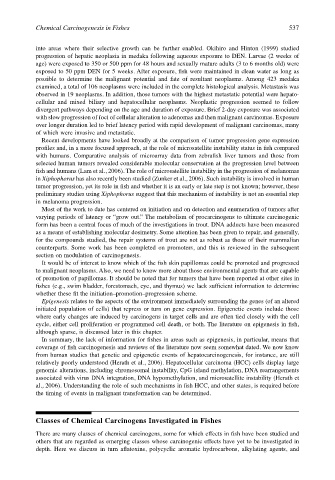Page 557 - The Toxicology of Fishes
P. 557
Chemical Carcinogenesis in Fishes 537
into areas where their selective growth can be further enabled. Okihiro and Hinton (1999) studied
progression of hepatic neoplasia in medaka following aqueous exposure to DEN. Larvae (2 weeks of
age) were exposed to 350 or 500 ppm for 48 hours and sexually mature adults (3 to 6 months old) were
exposed to 50 ppm DEN for 5 weeks. After exposure, fish were maintained in clean water as long as
possible to determine the malignant potential and fate of resultant neoplasms. Among 423 medaka
examined, a total of 106 neoplasms were included in the complete histological analysis. Metastasis was
observed in 19 neoplasms. In addition, those tumors with the highest metastatic potential were hepato-
cellular and mixed biliary and hepatocellular neoplasms. Neoplastic progression seemed to follow
divergent pathways depending on the age and duration of exposure. Brief 2-day exposure was associated
with slow progression of foci of cellular alteration to adenomas and then malignant carcinomas. Exposure
over longer duration led to brief latency period with rapid development of malignant carcinomas, many
of which were invasive and metastatic.
Recent developments have looked broadly at the comparison of tumor progression gene expression
profiles and, in a more focused approach, at the role of microsatellite instability status in fish compared
with humans. Comparative analysis of microarray data from zebrafish liver tumors and those from
selected human tumors revealed considerable molecular conservation at the progression level between
fish and humans (Lam et al., 2006). The role of microsatellite instability in the progression of melanomas
in Xiphophorus has also recently been studied (Zunker et al., 2006). Such instability is involved in human
tumor progression, yet its role in fish and whether it is an early or late step is not known; however, these
preliminary studies using Xiphophorus suggest that this mechanism of instability is not an essential step
in melanoma progression.
Most of the work to date has centered on initiation and on detection and enumeration of tumors after
varying periods of latency or “grow out.” The metabolism of procarcinogens to ultimate carcinogenic
form has been a central focus of much of the investigations in trout. DNA adducts have been measured
as a means of establishing molecular dosimetry. Some attention has been given to repair, and generally,
for the compounds studied, the repair systems of trout are not as robust as those of their mammalian
counterparts. Some work has been completed on promoters, and this is reviewed in the subsequent
section on modulation of carcinogenesis.
It would be of interest to know which of the fish skin papillomas could be promoted and progressed
to malignant neoplasms. Also, we need to know more about those environmental agents that are capable
of promotion of papillomas. It should be noted that for tumors that have been reported at other sites in
fishes (e.g., swim bladder, forestomach, eye, and thymus) we lack sufficient information to determine
whether these fit the initiation–promotion–progression scheme.
Epigenesis relates to the aspects of the environment immediately surrounding the genes (of an altered
initiated population of cells) that repress or turn on gene expression. Epigenetic events include those
where early changes are induced by carcinogens in target cells and are often tied closely with the cell
cycle, either cell proliferation or programmed cell death, or both. The literature on epigenesis in fish,
although sparse, is discussed later in this chapter.
In summary, the lack of information for fishes in areas such as epigenesis, in particular, means that
coverage of fish carcinogenesis and reviews of the literature now seem somewhat dated. We now know
from human studies that genetic and epigenetic events of hepatocarcinogenesis, for instance, are still
relatively poorly understood (Herath et al., 2006). Hepatocellular carcinoma (HCC) cells display large
genomic alterations, including chromosomal instability, CpG island methylation, DNA rearrangements
associated with virus DNA integration, DNA hypomethylation, and microsatellite instability (Herath et
al., 2006). Understanding the role of such mechanisms in fish HCC, and other states, is required before
the timing of events in malignant transformation can be determined.
Classes of Chemical Carcinogens Investigated in Fishes
There are many classes of chemical carcinogens, some for which effects in fish have been studied and
others that are regarded as emerging classes whose carcinogenic effects have yet to be investigated in
depth. Here we discuss in turn aflatoxins, polycyclic aromatic hydrocarbons, alkylating agents, and

